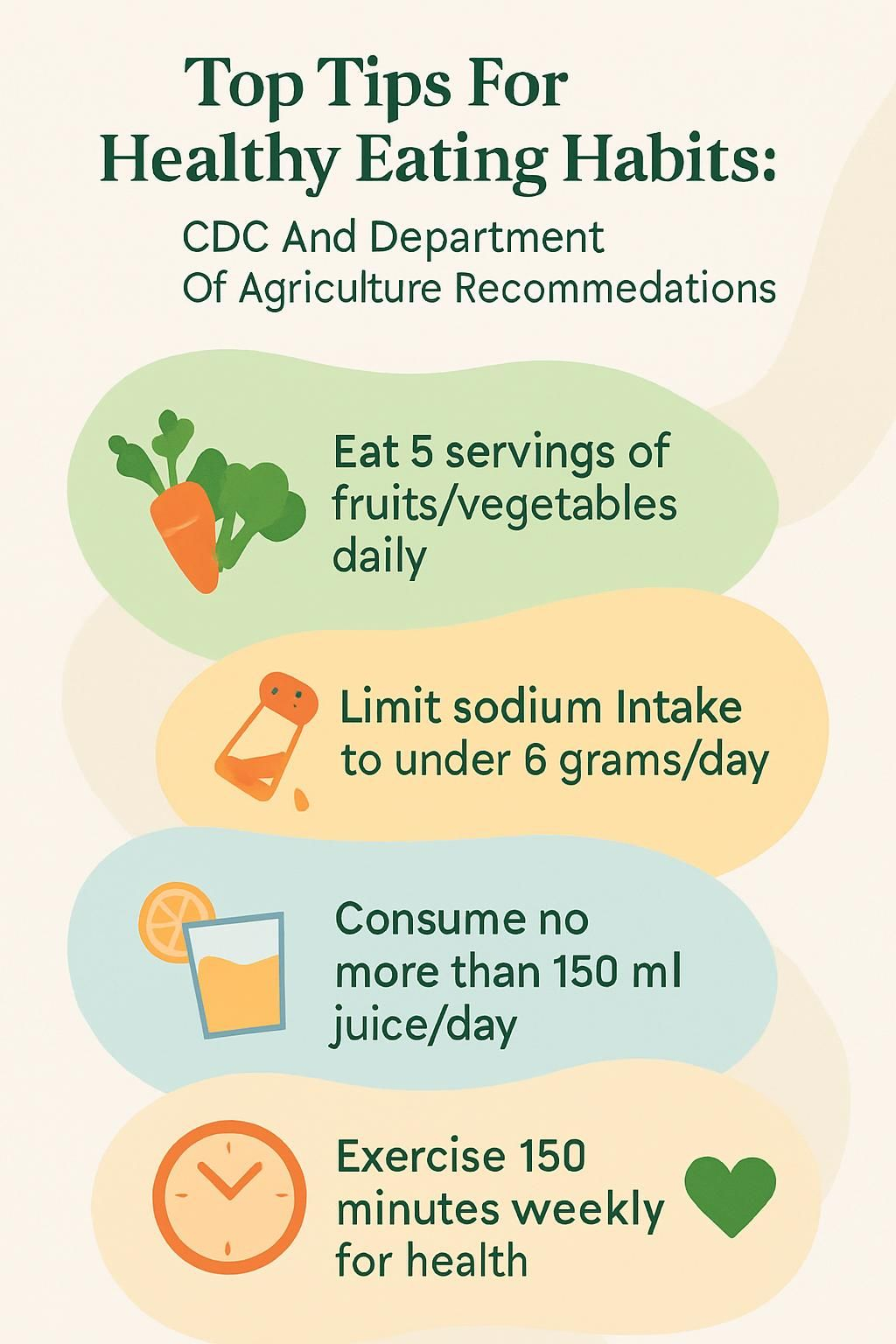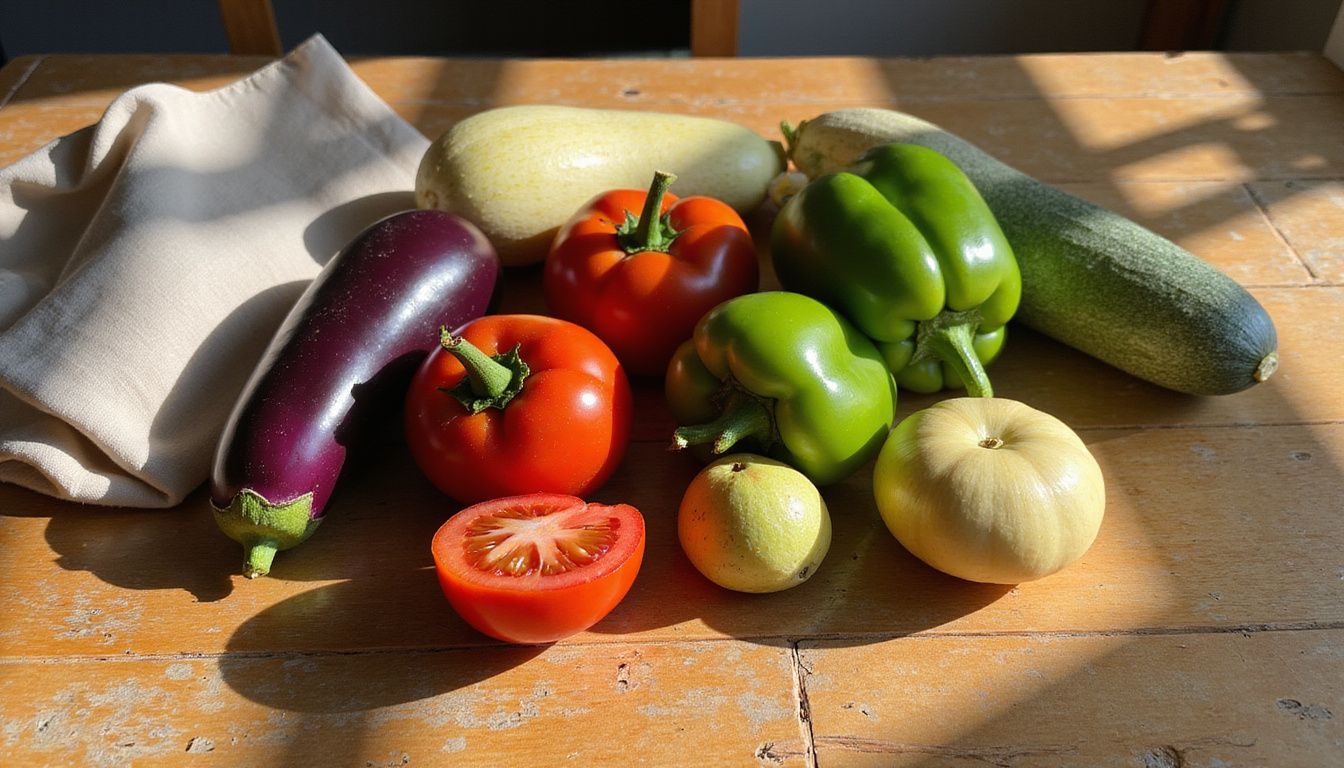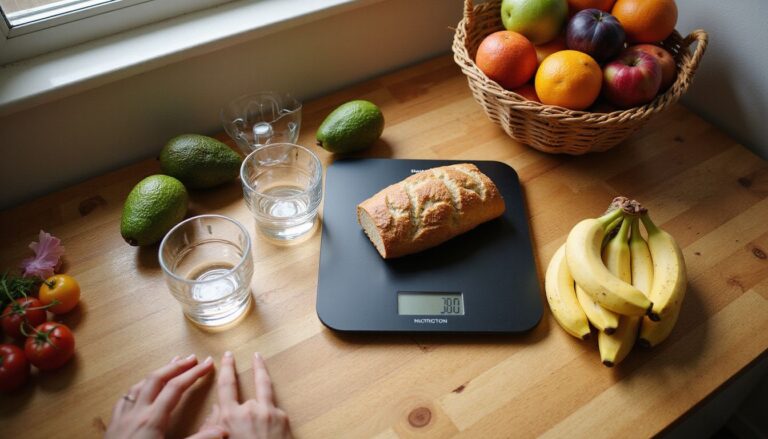Top Tips For Healthy Eating Habits: CDC And Department Of Agriculture Recommendations
Our Nutrition Assistant AI Suite will transform your body. You will lose fat, get toned, and build muscle. Gain confidence and optimal health.
You may feel that fast food is easier than healthy eating. Many adults take in more calories than they need, which raises the risk for weight gain, heart disease, and type 2 diabetes. This guide shares tips for healthy eating habits you can use today, including smarter choices, portion control, label reading, and MyPlate basics. Start small today; your body will thank you.
Key Takeaways
- Eat at least five servings of fruits and vegetables daily, choose whole grains and lean proteins, and limit salt to under 6 grams per day.
- Swap saturated fat for unsaturated fat to support your heart. Many adults should keep saturated fat to about 20 grams for women and 30 grams for men per day.
- Sugary drinks raise the risk for obesity and type 2 diabetes. Keep juice to a small glass, about 150 milliliters, or less.
- Pair healthy food with movement. Most adults need at least 150 minutes of moderate activity each week under federal guidelines.
- Mindful eating, such as using smaller plates and avoiding screens, can cut calorie intake by up to 20 percent, according to recent research.

Why Are Healthy Eating Habits Important?

Healthy eating habits help you reach and keep a healthy weight. They also lower your risk of serious disease later in life. Small daily choices add up over time, which is why building a healthy diet is worth the effort.
What Are the Benefits of Healthy Eating for Physical Health?
A balanced diet fuels your body and protects your heart. The Dietary Guidelines for Americans 2020 to 2025 call for fruits, vegetables, whole grains, lean proteins, and low-fat dairy to lower the risk of heart disease, type 2 diabetes, and obesity.
Choosing fish or poultry in place of fatty red meat cuts saturated fat. Staying within your calorie needs helps prevent weight gain. Less salt supports healthy blood pressure. Limiting added sugar helps prevent tooth decay and metabolic problems.
Nutritious foods also support your immune system, so you can fight off infections more easily. Kids benefit as well because balanced meals support growth and steady energy for school and play.
How Does Healthy Eating Improve Mental Well-Being?
What you eat affects how you feel. Balanced meals with produce, whole grains, lean protein, beans, nuts, and yogurt give your brain steady fuel. Studies link nutrient-rich patterns with a lower risk of depression and anxiety.
Vitamins and minerals support brain function, which helps with focus and mood. Mindful eating slows you down, so you notice hunger and fullness signals. At my house, a weekly veggie soup night helped our family feel more connected during busy weeks.
How Does Healthy Eating Help Prevent Diseases?
Keeping added sugar, salt, and unhealthy fats low protects your heart and blood vessels. Eating fewer processed foods helps with weight control and lowers your risk for obesity. More fruits and vegetables are linked with lower cancer risk.
Choose unsaturated fats, such as olive oil, avocado, soybean oil, and nuts, to support healthy cholesterol levels. Keep alcohol in check, since heavy drinking is tied to many chronic conditions.
Good nutrition is essential for preventing chronic illness,says the CDC.
Regular physical activity and balanced meals together cut the risk of type 2 diabetes. Use MyPlate from the Department of Agriculture to plan balanced plates at home and in the grocery store.
CDC and Department of Agriculture Healthy Eating Recommendations
CDC and USDA tips are based on strong research. They show you how to make healthy choices that lower disease risk and support long-term wellbeing.
Why Should You Emphasize Fruits and Vegetables?
Aim for at least five servings each day. Produce provides fiber, potassium, and antioxidants with few calories. These nutrients help protect your heart and reduce the risk of diabetes and some cancers.
Add fresh options like pineapple packed in water, mango, or sliced kiwi to cereal. Choose vegetables that are fresh, frozen without sauce, or canned in water. Sauté spinach with a light spray of oil for a fast side. Keep juice to one small glass, about 150 milliliters, since it can be high in sugar. Try one new vegetable each week to keep meals interesting.
How to Incorporate Whole Grains into Your Diet?
Whole grains add fiber and essential nutrients your body needs. Many people do not get enough, so put them on your plate daily.
- Replace white bread, pasta, and rice with 100 percent whole wheat bread, whole wheat pasta, or brown rice. Starchy foods can make up about one third of daily intake.
- Pick a breakfast cereal with “whole grain” as the first ingredient. Keep added sugar low and fiber high.
- Include a starchy food with each main meal, such as potatoes with skin, whole grain bread, or brown rice, to feel full longer.
- Make overnight oats and top with bananas or berries for fiber and steady energy.
- Snack on air-popped popcorn or roasted chickpeas instead of desserts or sweetened drinks.
- Bake with whole wheat flour for pancakes or muffins to boost nutrients without extra fat.
- Choose 100 percent whole grain wraps for chicken or veggie lunches instead of white tortillas.
- Read labels for “whole” and “100% whole grain.” Skip products that list lard or syrup near the top of the ingredients.
- Batch cook chili with beans and lentils, then serve with brown rice. Cooking at home helps you use olive oil and eat less salt.
- Drink water with starchy meals rather than soft drinks to reduce calories from sugar common in the Western pattern diet.
What Are Good Sources of Lean Proteins?
Lean proteins help maintain muscle while limiting saturated fat. Fish like salmon, trout, sardines, and mackerel are great choices. Aim for two fish servings each week, with at least one being oily fish. White fish such as cod or haddock adds variety with fewer calories.
Grill or bake poultry and lean cuts of meat instead of frying. Eggs provide high-quality protein when cooked with little added fat. Beans, lentils, tofu, nuts, and seeds add plant protein. Check labels on canned or smoked fish, since some products contain a lot of salt.
Which Healthy Fats Should You Choose?
Choose mostly unsaturated fats from vegetable oils like olive or canola, and from fish, nuts, and seeds. These fats support heart health and improve cholesterol levels.
Keep saturated fat low, about 20 grams per day for most women and 30 grams for most men. Children under 11 need less. Young children under five need higher fat for growth, so low-fat diets are not right for them. Limit butter, cream, full-fat cheese, fatty meats, and foods with trans fat.
Why Consume Low-Fat or Fat-Free Dairy?
Fat-free or low-fat dairy gives you calcium and vitamin D without a lot of saturated fat. Milk, yogurt without added sugar, and fortified soy beverages are smart options. Canned salmon with bones also provides calcium.
If you choose dairy alternatives, pick options fortified with calcium and vitamin D. These choices help control calories while supporting bone health and growth.
How Can You Build Healthy Eating Habits?
Build habits one small step at a time. Simple changes add up and make it easier to stick with a healthy diet.
How to Plan Balanced Meals Effectively?
Planning helps you get the right nutrients without overeating. Use clear guides and keep track to see what works.
- Use the plate model. Fill half your plate with vegetables and fruits at every meal, as shown in MyPlate.
- Include whole grains such as brown rice, whole wheat bread, or oats for steady energy and digestion.
- Add lean proteins like eggs, grilled chicken, fish, beans, or nuts to support muscles.
- Pick healthy fats like olive oil or rapeseed oil instead of fats high in saturated or trans fat.
- Drink water instead of soda or energy drinks. Many people do well with about eight 8-ounce glasses daily.
- Limit foods high in calories, sugar, and salt. Skip ultra-processed items like fries to lower heart risk.
- Use MyPlate portions to control serving sizes. Do not skip meals, since that can lead to overeating later.
- Cook at home more often using grilling or sautéing. Takeout is often higher in sodium and unhealthy fats.
- Track your intake with a simple log to spot gaps or patterns that do not meet your goals.
- Choose low-fat or fat-free dairy for calcium while limiting extra calories from full-fat versions.
Prepping breakfast ahead keeps you on track. Overnight oats with berries and nuts helped me stay consistent during busy weeks teaching.
What Are Tips for Practicing Portion Control?
Portion control supports a healthy weight. A few simple tools make it easier to gauge how much you need.
- Use smaller plates or bowls so portions look and feel satisfying.
- Read labels for serving sizes and calories. Many adults eat more than they realize.
- Serve about 80 grams of fruits or vegetables per portion, 30 grams for dried fruit, and 150 milliliters for juice.
- Keep treats in small packages or single portions to curb overeating.
- Avoid eating from large bags or boxes, since it is hard to track how much you ate.
- Divide snacks into single servings once you bring them home.
- Eat slowly and pause between bites to notice fullness.
- Use measuring cups or a scale a few times to learn what a serving looks like for pasta, rice, cheese, and nuts.
These steps help you regulate intake. Next, see why regular meals matter for building strong habits.
Why Should You Avoid Skipping Meals?
Regular meals help keep blood sugar steady and your metabolism active. Skipping meals often leads to overeating later, especially high-sugar or high-fat foods.
People who skip breakfast tend to miss key nutrients like fiber and vitamins. Consistent eating patterns support better weight management by reducing hunger spikes. During long school days, skipping lunch left me tired and craving snacks, not the balanced foods I planned.
How Much Water Should You Drink to Stay Hydrated?
Aim for 6 to 8 glasses of fluids daily, in addition to water in foods. Water should be your main drink because it aids digestion and supports energy. Lower-fat milk or low-sugar drinks can add variety, but keep sugary beverages to a minimum.
Limit fruit juice and other sweet drinks so they do not exceed about 150 milliliters in a day. I keep a refillable bottle at my desk and sip through the day. It helps me stay alert and active at work.
How Can You Minimize Distractions While Eating?
Turn off screens before meals. Distraction makes it easy to overeat and hard to notice fullness. Mindful eating helps you taste your food, digest well, and stop when satisfied.
Sitting at a table in a quiet space can improve how much you enjoy the meal and helps with portion control. Studies suggest mindful eating can reduce calorie intake compared with distracted dining.
Which Foods Should You Limit or Avoid?
Some foods make it harder to manage weight and health. Knowing which ones to limit lets you build a stronger plan.
Why Limit Processed and Ultra-Processed Foods?
Highly processed foods often pack added sugars, salt, and unhealthy fats. Up to 75 percent of daily salt can come from packaged meals, soups, and sauces. Too much salt raises blood pressure and heart risk.
Ultra-processed snacks and drinks also add “free sugars,” which make weight control harder. Cutting back supports better nutrition and helps you lower sodium. I swapped packaged snacks for fresh fruit for one week and avoided extra sugar without feeling hungry.
What Are the Risks of Sugary Drinks?
Sodas and sweetened juices add many calories with few nutrients. Drinks with more than 22.5 grams of sugar per 100 grams are considered high in sugar. These beverages raise the risk of weight gain, obesity, and type 2 diabetes.
They can also harm your teeth. Keep juice servings small, about 150 milliliters. Reducing sugary drinks is one of the fastest ways to improve your diet.
How Do Saturated and Trans Fats Affect Health?
Too much saturated fat, found in fatty meats, butter, hard cheese, cream, cakes, and pastries, raises heart disease risk. Aim for roughly 20 grams per day for most women and 30 grams for most men, unless your clinician advises otherwise. Children need less, and kids under five should not follow low-fat diets.
Trans fats are worse because they raise bad cholesterol and lower good cholesterol. Health experts advise avoiding trans fats. Choose unsaturated fats, such as vegetable oils and fish, to support healthy cholesterol. I swapped butter for olive oil in recipes and felt lighter after meals. My blood pressure readings also improved.
Why Is Excessive Sodium Harmful?
Too much sodium raises blood pressure and increases the risk of heart disease and stroke. Most sodium comes from packaged foods, not the salt shaker. Adults should keep total salt to about 6 grams per day. Foods with more than 1.5 grams of salt per 100 grams are considered high.
Reducing sodium helps protect your heart over time. After a week of salty packaged meals, I noticed headaches. Cutting back steadied my energy in the afternoons.
What Are the Effects of Drinking Alcohol in Large Quantities?
Heavy drinking strains your liver and heart. It raises the risk of high blood pressure, fatty liver disease, cirrhosis, and several cancers. Alcohol adds seven calories per gram with little nutrition, which makes weight control harder.
It also impairs judgment and can lead to overeating. CDC data show excessive drinking causes more than 140,000 deaths per year in the United States. Choosing water or seltzer at social events supports better choices later in the night.
Lifestyle Strategies to Support Healthy Eating
Practical routines make healthy eating easier. A few daily habits can keep your nutrition on track.
How Does Preparing Meals at Home Help?
Home cooking gives you control over portions and ingredients. You can center meals on fruits, vegetables, lean proteins, whole grains, and healthy fats while limiting salt and sugar. Simple recipes like sweet potato hash with eggs or white bean and avocado wraps fit most schedules.
Cooking at home can save money and reduce waste. It also teaches kids lifelong skills. My family enjoys building pulled turkey tostadas together. Dinner feels fun, and it meets our goals.
Why Is It Important to Read Food Labels Carefully?
Labels show calories, portion size, and nutrients such as added sugar, sodium, saturated fat, and trans fat. Packaged foods with more than 22.5 grams of sugar or 1.5 grams of salt per 100 grams count as high. These cutoffs are helpful for quick comparisons.
Use labels to choose minimally processed options and to find products lower in sugar, salt, and saturated fat. Last week I compared yogurts and picked the tub with less added sugar for a better snack.
Summary: Labels help you pick foods that fit your healthy eating habits and your goals.
How Can Physical Activity Support Healthy Eating?
Eating well and moving more work together. Exercise helps you balance calories in with calories out and improves how your body uses food. Most adults should aim for at least 150 minutes of moderate activity each week.
Activity improves blood sugar control and metabolism. A BMI calculator can help you check progress when you combine diet changes with movement. I used a 12-week plan to track meals and walks side by side, which kept my energy steady while I lost extra pounds safely.
What Is Mindful Eating and How to Practice It?
Mindful eating means paying attention to hunger and fullness while focusing on your meal. It helps you enjoy food and avoid overeating.
- Eat without screens so you can notice your food and your body.
- Pause before eating to check if you are truly hungry. Recheck halfway through the meal.
- Take small bites and chew slowly to improve digestion and satisfaction.
- Express brief gratitude for your meal to build awareness and satisfaction.
- Use a simple hunger scale from 1 to 10. Aim to stop around 6 or 7.
- Drink water with meals instead of soda or juice.
- Choose a calm setting to help you focus on flavors and texture.
- Use these skills daily. Research links mindful eating with better weight control and fewer stress-driven eating episodes.
- If cravings show up during stress, notice them without judgment. Awareness can prevent choices you later regret.
How Can Managing Stress Prevent Emotional Eating?
Stress can push you toward snack foods and larger portions. Physical activity such as walking or yoga is a proven stress tool and helps steady your energy. Lower stress levels often reduce cravings.
Mindful eating helps you separate true hunger from emotion. Support from friends or family also matters. Quick check-ins kept me motivated on tough weeks. Making stress care part of your routine protects your healthy eating habits.
Special Considerations for Different Groups
Needs change across life stages. A few age-specific tips can help you adjust your plan.
What Are Healthy Eating Tips for Children and Adolescents?
Kids and teens need fuel for growth and learning. Set the tone at home with balanced choices and regular meals.
- Serve a variety from all food groups, including whole grains, fruits, vegetables, lean proteins, and low-fat dairy.
- Aim for five servings of fruits and vegetables daily to support immunity and growth.
- Limit processed foods high in added sugar, saturated fat, and sodium.
- Choose whole grains like whole wheat bread, brown rice, and oatmeal for fiber.
- Offer lean protein from fish, poultry without skin, beans, tofu, or eggs.
- Use low-fat or fat-free dairy for children over five to support bones.
- Hydrate with water, and limit soda and fruit punches to reduce cavities and extra calories.
- Use age-appropriate portions and smaller plates to prevent overeating.
- Let kids help plan and prepare meals to build skills and interest.
- Make family meals regular to improve diet quality and support mental health.
My niece started packing her lunches with a parent’s help. Healthy eating became a fun project, not a chore.
How Should Adults and Seniors Adjust Their Diets?
Many men need about 2,500 calories per day, and many women need about 2,000. If you want to lose weight, reduce calories and increase activity. As you age, metabolism may slow, so you may need fewer calories but more nutrient-dense foods.
Focus on produce, whole grains, and lean proteins. Get enough calcium and vitamin D for bone health through low-fat dairy or fortified choices. Limit saturated fat and sodium to protect your heart. Smaller meals may work better if appetite is low. Checking BMI can help you stay in a healthy range.
Measuring cups at my parents’ meals helped us avoid overeating and focus on nutrient-dense foods instead of empty calories.
What Nutritional Needs Do Pregnant and Breastfeeding Women Have?
Pregnancy and breastfeeding increase calorie and nutrient needs. Iron is key for preventing anemia, about 27 milligrams daily during pregnancy. Good sources include lean meats, beans, and fortified cereals.
Calcium needs are about 1,000 milligrams daily, and folic acid should be at least 600 micrograms to lower the risk of birth defects. Vitamin D, about 600 IU daily, helps your body use calcium. Stay hydrated. Avoid high-mercury fish like shark or swordfish, keep caffeine under 200 milligrams per day, and avoid alcohol during pregnancy and nursing. If nausea is a problem, try small frequent meals.
Sample Healthy Recipes and Meal Ideas
Use these quick ideas to build a week of balanced meals without extra stress.
What Is a Healthy Breakfast Option Like Overnight Oats with Fresh Berries?
Overnight oats make a fast, nutrient-rich breakfast that fits CDC and USDA guidance. Combine whole grain oats with low-fat milk or yogurt for protein and calcium. Top with 80 grams of fresh berries for fiber and antioxidants.
Keep added sugar low. Whole grains give complex carbs for steady energy. Making this the night before helps you avoid skipping breakfast on busy mornings.
How to Prepare a Nutritious Lunch Such as Grilled Chicken Salad with Olive Oil Dressing?
Grill a lean chicken breast to get about 26 grams of protein per 3-ounce serving. Slice it over mixed greens like spinach or romaine. Add one serving of colorful vegetables, such as tomatoes, cucumbers, and carrots, for crunch and vitamins.
Dress with olive oil and herbs instead of creamy dressings high in sugar or saturated fat. Add one half cup of quinoa if you want extra fiber. I make this most weeks because it tastes fresh, and the portions are easy to manage.
What Are Simple Dinner Ideas Like Baked Salmon with Steamed Vegetables?
Baked salmon provides protein and omega-3 fats for heart health. Bake with lemon and herbs, using minimal oil. Pair with steamed vegetables like broccoli or green beans to keep nutrients and add fiber.
Add a side of brown rice or quinoa for balance. This approach keeps calories moderate and nutrition high.
What Are Healthy Snack Choices Like Veggie Sticks with Hummus?
Veggie sticks with hummus are simple and filling. Use carrots, bell peppers, or cucumbers, about 80 grams per serving. Hummus adds plant protein and fiber from chickpeas to steady blood sugar.
These snacks are low in added sugar and unhealthy fats. Choosing raw vegetables daily helps you get a range of vitamins and minerals.
Tools and Resources for Healthy Eating
Helpful tools can remove guesswork. Use them to plan, shop, and track with less effort.
How Can MyPlate Guidelines Help You Eat Healthier?
MyPlate shows a simple picture of a balanced plate. Fill half with fruits and vegetables. Add whole grains, lean protein, and low-fat or fat-free dairy. The MyPlate Plan suggests portions based on your age, sex, height, weight, and activity level.
Use free tools like a daily food diary to track what you eat and compare your habits to the guidelines. I started building plates using MyPlate in 2024 and noticed better energy by midafternoon.
What Food Assistance Programs Are Available?
Several programs help families access healthy food. SNAP provides monthly benefits for groceries. WIC supports pregnant women, infants, and children. School meal programs offer free or reduced-price breakfasts and lunches.
Local food banks and community centers can help during tough times. Volunteering at a pantry showed me how much fresh produce and staples can improve family wellbeing.
What Are Useful Online Meal Planning Tools?
Online meal planners help you map meals, build grocery lists, and track nutrition. Tools such as MyPlate.gov, Eat This Much, and Mealime offer recipes with calorie and nutrient details. Many allow filters for low-sodium or vegetarian needs.
These planners save time at the store and reduce last-minute fast food choices. I often schedule dishes in a free app so I stay focused on healthier options during busy weeks.
Conclusion
Healthy eating habits support a healthy weight and long-term health. Follow CDC and USDA guidance to eat more fruits, vegetables, whole grains, lean proteins, and healthy fats. Limit sugar, salt, and processed foods. Plan balanced meals, practice portion control, and drink enough water to stay hydrated.
Small, steady steps make change stick. If you have a medical condition, allergies, or special nutrition needs, talk with a licensed clinician or registered dietitian for personal advice.
Sources: Centers for Disease Control and Prevention; U.S. Department of Agriculture, Dietary Guidelines for Americans 2020-2025; peer-reviewed nutrition research on mindful eating and ultra-processed foods.
FAQs
1. What are the main healthy eating habits recommended by the CDC and Department of Agriculture?
The Centers for Disease Control and Prevention and United States Department of Agriculture recommend eating a variety of fruits, vegetables, whole grains, lean proteins such as poultry or fish, and low-fat dairy products. They advise limiting added sugars, sodium, and saturated fats.
2. How much fruit and vegetable intake do these agencies suggest daily?
Both organizations encourage adults to eat at least five servings of fruits and vegetables each day. This guidance is based on research showing that higher produce consumption lowers risk for chronic diseases like heart disease or type 2 diabetes (USDA Dietary Guidelines 2020-2025).
3. Are there specific guidelines about portion sizes or meal planning?
Yes; both agencies stress controlling portion sizes to avoid overeating. The USDA’s MyPlate tool helps people plan meals with balanced portions from all food groups while keeping calories in check.
4. Can you share a personal example applying these recommendations?
Last year I started following the MyPlate method during lunch at work by filling half my plate with salad greens and carrots then adding grilled chicken breast plus brown rice on the side. Over several months I noticed more energy throughout my afternoons which matches findings from studies linking balanced meals to better focus (CDC Healthy Eating Tips).
Summary: These tips highlight evidence-based advice from national health authorities focusing on diverse foods in proper amounts for long-term wellness benefits supported by scientific data.







